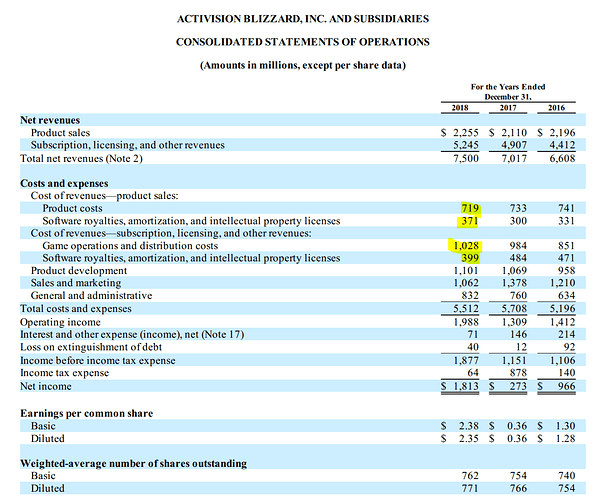Hey,
While screening for stocks, I found that there are some deviations in gross profit from what I would’ve inferred from the companies’ financial statements.
For example, take ActivisionBlizzard’s (ATVI) data from last fiscal year. According to Portfolio123 / Compustat, COGS amounts to $1507 Million. However, when I add up the individual lines in income statement, I end up with $2517 Million (719 + 371 + 1028 + 399). Is there any specific difference in how Compustat calculates COGS?
Link to financial statement: [u]https://investor.activision.com/static-files/0f4309eb-c4a5-4bb3-a2b8-d589caf16417[/u]

Data presented on portfolio123 (or anyplace else on the internet) cannot be presumed to be readily replicable by looking at 10-Ks or 10-Qs. All raw data is “standardized” based on the provider’s protocol. And even within standardization protocols, there are differences between those that are intended for display and those that are intended for research.
For more info on this, please refer to this document in the Help area: https://www.portfolio123.com/doc/side_help_item.jsp?id=92
Thanks Marc! I already thought of something like that :).
I checked on CapitalIQ. They get the same calculation that you do and then deduct $1,010M for depreciation and amortization.
Thanks for your response. That’s really insightful and explains the difference.
I know that’s out of your control but I completely disagree how CapitalIQ treats depreciation and amortization for calculating COGS in this specific case. For anyone who’s interested, here is why:
- I think it does not make sense to deduct the total amount of depreciation and amortization of $1010m from COGS. I’m pretty sure the company does not include their PP&E depreciation in COGS. However, it should mostly consist of amortization of previously capitalized software development cost (this is also what the notes to the financial statements say). This amount should be $489m according to the cash flow statement. Even if you would adjust COGS for depreciation and amortization (probably because they think it should not be included in COGS) then you should only adjust for the numbers that are previously included in COGS, which is only amortization of capitalized software development.
- Additionally, I think that even deducting capitalized software development cost does not make sense. Even if previously capitalized - this is cost directly related to producing the product. There’s a good reason ATVI puts them to COGS.
This case show sagain how difficult it must be for data providers to set up and maintain standardized fundamental financial databases.
Different analysts will sometimes differ as to their calls on some things.
I haven’t read the footnotes for ATVI, but as a gamer I know that WoW is getting long in the tooth in video-game years. It could be that they’re amortizing it related to its subscription stream in some way, which would make it a variable cost.
But that’s just speculation, and probably poor speculation. It could also be that they’re maintaining consistency with some data collection call made 10 years ago, or following an industry standard.
Or even that they’re right. 
From our perspective, we’re not going in and changing it on our end. This is one of those situations where the data provider provides data and we present it.

